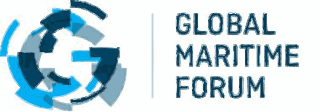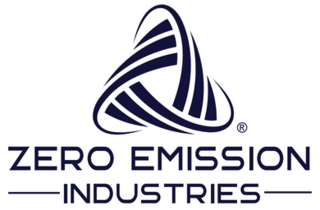Related Research Articles

Steelmaking is the process of producing steel from iron ore and/or scrap. In steelmaking, impurities such as nitrogen, silicon, phosphorus, sulfur and excess carbon are removed from the sourced iron, and alloying elements such as manganese, nickel, chromium, carbon and vanadium are added to produce different grades of steel.

A.P. Møller – Mærsk A/S, also known simply as Maersk, is a Danish shipping and logistics company founded in 1904 by Arnold Peter Møller and his father Peter Mærsk Møller.
Methanol fuel is an alternative biofuel for internal combustion and other engines, either in combination with gasoline or independently. Methanol (CH3OH) is less expensive to sustainably produce than ethanol fuel, although it is more toxic than ethanol and has a lower energy density than gasoline. Methanol is safer for the environment than gasoline, is an anti-freeze agent, prevents dirt and grime buildup within the engine, has a higher ignition temperature, and produces horsepower equivalent to that of super high-octane gasoline. It can readily be used in most modern engines. To prevent vapor lock due to being a simple, pure fuel, a small percentage of other fuel or certain additives can be included. Methanol may be made from fossil fuels or renewable resources, in particular natural gas and coal, or biomass respectively. In the case of the latter, it can be synthesized from CO2 (carbon dioxide) and hydrogen. The vast majority of methanol produced globally is currently made with gas and coal. However, projects, investments, and the production of green-methanol has risen steadily into 2023. Methanol fuel is currently used by racing cars in many countries and has seen increasing adoption by the maritime industry.

The hydrogen economy is an umbrella term for the roles hydrogen can play alongside low-carbon electricity to reduce emissions of greenhouse gases. The aim is to reduce emissions where cheaper and more energy-efficient clean solutions are not available. In this context, hydrogen economy encompasses the production of hydrogen and the use of hydrogen in ways that contribute to phasing-out fossil fuels and limiting climate change.

Energy is sustainable if it "meets the needs of the present without compromising the ability of future generations to meet their own needs." Definitions of sustainable energy usually look at its effects on the environment, the economy, and society. These impacts range from greenhouse gas emissions and air pollution to energy poverty and toxic waste. Renewable energy sources such as wind, hydro, solar, and geothermal energy can cause environmental damage, but are generally far more sustainable than fossil fuel sources.

Aircraft engines produce gases, noise, and particulates from fossil fuel combustion, raising environmental concerns over their global effects and their effects on local air quality. Jet airliners contribute to climate change by emitting carbon dioxide, the best understood greenhouse gas, and, with less scientific understanding, nitrogen oxides, contrails and particulates. Their radiative forcing is estimated at 1.3–1.4 that of CO2 alone, excluding induced cirrus cloud with a very low level of scientific understanding. In 2018, global commercial operations generated 2.4% of all CO2 emissions.

Marine propulsion is the mechanism or system used to generate thrust to move a watercraft through water. While paddles and sails are still used on some smaller boats, most modern ships are propelled by mechanical systems consisting of an electric motor or internal combustion engine driving a propeller, or less frequently, in pump-jets, an impeller. Marine engineering is the discipline concerned with the engineering design process of marine propulsion systems.
A hydrogen ship is a hydrogen fueled ship, using an electric motor that gets its electricity from a fuel cell, or hydrogen fuel in an internal combustion engine.

The environmental effects of shipping include air pollution, water pollution, acoustic, and oil pollution. Ships are responsible for more than 18% of nitrogen oxides pollution, and 3% of greenhouse gas emissions.
The GREEN cell shipping concept is a new concept for powering merchant shipping vessels using containerized power units and a global logistics chain to manage these containers. GREEN cell stands for Global Renewable Electrical Energy Network cell. The concept resulted from a thought experiment process involving engineers working for the ABB Group that took place on March 13, 2009 in Oslo, Norway. The concept was subsequently introduced in an ABB magazine, and remains under development, as part of an open innovation process.
The Danish Maritime Authority is the agency of the Danish Government responsible for regulating and administrating Danish maritime affairs. The Danish Maritime Authority (DMA) is part of the Ministry of Industry, Business, and Financial Affairs. The Agency consists of the central authority and eight vision offices, including the office in Nuuk and the Centre for Maritime Health on Fanø. Its headquarters are in Korsør.

Maersk Line is a Danish international container shipping company and the largest operating subsidiary of Maersk, a Danish business conglomerate. Founded in 1928, it is the world's second largest container shipping company by both fleet size and cargo capacity, offering regular services to 374 ports in 116 countries. In 2019, it employed 83,625 people where 18,398 of which are vessel crew and the other 65,227 are processing and operations personnel in offices and ports. Maersk Line operates over 708 vessels and has a total capacity of about 4.1 million TEU.
Wind assisted propulsion is the practice of decreasing the fuel consumption of a merchant vessel through the use of sails or some other wind capture device. Sails used to be the primary means of propelling ships, but with the advent of the steam engine and the diesel engine, sails came to be used for recreational sailing only. In recent years with increasing fuel costs and an increased focus on reducing emissions, there has been increased interest in harnessing the power of the wind to propel commercial ships.

The Global Maritime Forum is an international not-for-profit organisation for the global maritime industry. It convenes leaders from across the maritime community with policy-makers, experts, NGOs and other influential decision-makers.

Heavy fuel oil (HFO) is a category of fuel oils of a tar-like consistency. Also known as bunker fuel, or residual fuel oil, HFO is the result or remnant from the distillation and cracking process of petroleum. For this reason, HFO is contaminated with several different compounds including aromatics, sulfur, and nitrogen, making emissions upon combustion more polluting compared to other fuel oils. HFO is predominantly used as a fuel source for marine vessel propulsion using marine diesel engines due to its relatively low cost compared to cleaner fuel sources such as distillates. The use and carriage of HFO on-board vessels presents several environmental concerns, namely the risk of oil spill and the emission of toxic compounds and particulates including black carbon. The use of HFOs is banned as a fuel source for ships travelling in the Antarctic as part of the International Maritime Organization's (IMO) International Code for Ships Operating in Polar Waters (Polar Code). For similar reasons, an HFO ban in Arctic waters is currently being considered.
The Energy Transitions Commission (ETC) is an international think tank, focusing on economic growth and climate change mitigation. It was created in September 2015 and is based in London. The commission currently contains 32 commissioners from a selection of individuals and company and government leaders.

The e5 Project is a Japanese consortium with the purpose of developing renewably-powered commercial ships.

The Initial IMO Strategy on the reduction of GHG emissions from ships, or Initial IMO GHG Strategy, is the framework through which the International Maritime Organization (IMO) aims to reduce greenhouse gas (GHG) emissions from international maritime shipping. GHG emissions from shipping are about 3% of total GHG emissions, and under this strategy the IMO envisions their elimination within this century. However many companies and organizations say shipping should be decarbonized by 2050.

Zero Emission Industries, Inc. (ZEI) is an American hydrogen technology company founded in 2018 and headquartered in the San Francisco Bay Area. Previously known as Golden Gate Zero Emission Marine, ZEI designs and manufactures hydrogen fuel cell power systems and hydrogen refueling solutions with a focus on maritime applications.
MV Sea Change is first hydrogen fuel cell vessel in the United States and the first commercial fuel cell ferry in the world.
References
- ↑ "Climate change: Shipping agrees net-zero goal but critics chide deal". BBC News . 2023-07-07. Retrieved 2023-09-06.
- ↑ Wittels, Jack (May 20, 2024). "How the Shipping Industry Is Trying to Cut Its Billion Tons of CO2 Emissions". www.bloomberg.com. Retrieved 2024-05-22.
- ↑ "Decarbonizing Shipping | UN Global Compact". unglobalcompact.org.
- ↑ "Decarbonizing maritime shipping". MIT Technology Review.
- ↑ Brennan, Chris. "Air, Sea, Truck, or Rail: What's the Best Shipping Mode in 2022".
- ↑ "IMO (2020) Work on GHG Emissions". IMO. Archived from the original on 2020-09-19.
- ↑ Reinsch, William Alan (2021-04-13). "Hydrogen: The Key to Decarbonizing the Global Shipping Industry?". Washington, D.C.: Center for Strategic and International Studies . Retrieved 2022-08-18.
- ↑ Munoz, Tony (2021-05-31). "Decarbonizing Shipping: A Conversation with Bo Cerup-Simonsen, CEO, Mærsk Mc-Kinney Møller Center for Zero Carbon Shipping". The Maritime Executive. Retrieved 2022-08-18.
- ↑ Baker, Marcus. "Deep Dive on Decarbonization of Maritime Industry". New York, NY: Marsh McLennan. Retrieved 2022-08-18.
- ↑ Mallouppas, George; Yfantis, Elias Ar (2021). "Decarbonization in Shipping Industry: A Review of Research, Technology Development, and Innovation Proposals". Journal of Marine Science and Engineering. 9 (4): 415. doi: 10.3390/jmse9040415 . ISSN 2077-1312.
- ↑ ""Fit" for Decarbonizing Maritime Shipping: Improvements Needed to Fuel EU Maritime Proposal to Meet coZEV Corporate Climate Ambitions". Washington, D.C.: The Aspen Institute. 2022-03-21. Retrieved 2022-08-18.
- ↑ Josephs, Jonathan (2021-04-21). "Climate change: Shipping industry calls for new global carbon tax". BBC News. Retrieved 2022-08-18.
- 1 2 "Shipping Industry Needs More R&D to Meet Decarbonization Goals". Plantation, FL: The Maritime Executive. 2021-11-03.
- ↑ "Shipping Decarbonization Weekly Insights". Breakwave Advisors. 8 August 2022. Retrieved 2022-08-18.
- ↑ "IMO-Singapore Future of Shipping Conference: Decarbonisation 2022". IMO. Retrieved 2022-08-18.
- ↑ "3rd Decarbonizing Shipping Forum". www.decarbonizingforum.com. Retrieved 2022-08-18.
- ↑ "SHIPPINGInsight Conference: The Unsung Heroes of Shipping's Decarbonization". ISACOL S.A.S. Ship Agents in Colombia. 2021-10-16. Retrieved 2022-08-18.
- ↑ "Decarbonizing Shipping (online training). Online blended learning training course that gives an overview of the realistic options that exist to meet the 2050 targets for CO2 reduction". DNV, Det Norske Veritas. Retrieved 2022-08-18.
- ↑ "Home". Poseidon Principles for Financial Institutions. Retrieved 2023-09-09.
- ↑ "Decarbonizing Maritime Transport (2018) International Transport Forum". 27 March 2018.
- ↑ McDonagh, Gray (2021). "Decarbonising ships, planes and trucks: An analysis of suitable low-carbon fuels for the maritime, aviation and haulage sectors" (PDF). Advances in Applied Energy. 1: 100008. doi: 10.1016/j.adapen.2021.100008 . S2CID 234247965.
- ↑ "Electric Tug Sparky Chistened in Auckland". Marine Propulsion. 2022-08-11. Retrieved 2022-08-18.
- ↑ "New Foss Hybrid Tug Steals the Show in LA". Professional Mariner. September 9, 2009. Retrieved 2022-08-18.
- ↑ "Second Foss Hybrid Tug Headed to SOCAL". Marine Propulsion. 2012-01-19. Retrieved 2022-08-18.
- ↑ "Svalbard Tour Boat Ushers New Technology—And a New Business Model". Marine Propulsion. 2022-08-01. Retrieved 2022-08-18.
- ↑ "Danish Electric Ferry Completes World-record 90km Voyage on a Single Charge". Marine Propulsion. 2022-08-17. Retrieved 2022-08-18.
- 1 2 3 Islam, Roumeen; Englert, Dominik (2022-03-16). "Infrastructure Podcast | Decarbonized Shipping". World Bank. Retrieved 2022-08-18.
- ↑ "Decarbonization of the shipping industry". CIBC Capital Markets. November 10, 2021. Retrieved 2022-08-18.
- ↑ Brown, Jennifer; Casarotto, Edoardo; Debatin, Maximilian; Ritsch, Nicola (2021-07-01). "Zero-carbon shipping: A sea of opportunities for developing countries". World Bank. Retrieved 2022-08-18.
- ↑ "Carnival's AIDA Cruises Makes Biofuels Foray". Marine Propulsion. New York, NY: New Wave Media. 2022-07-27. Retrieved 2022-08-18.
- 1 2 Bourboulis, Stamatis; Krantz, Randall; Mouftier, Lara (2022-04-11). "3 actions the industry can take to decarbonize shipping". World Economic Forum. Retrieved 2022-08-18.
- ↑ "Hydrotug: World's First Hydrogen-powered Tug Launched". MarineLink. 2022-05-23. Retrieved 2022-08-18.
- ↑ "Hydrotug: World's First Hydrogen-powered Tug Launched". Marine Propulsion. 2022-05-24. Retrieved 2022-08-18.
- ↑ Bourboulis, Stamatis; Krantz, Randall; Mouftier, Lara (2022-05-09). "Alternative fuels: Retrofitting ship engines". Global Maritime Forum . Retrieved 2022-08-18.
- ↑ Premack, Rachel; Williams, Melissa (2022-08-11). "A Shell executive reveals how the energy giant wants to decarbonize the shipping industry". FreightWaves. Retrieved 2022-08-18.
- ↑ Ajdin, Adis (2021-10-21). "Stena gets into the methanol retrofit business". Splash247. Retrieved 2022-08-18.
- ↑ Haines, Chantal (2021-10-22). "Stena partners with methanol producer for wide-ranging retrofit solution". Marine Industry News. Retrieved 2022-08-18.
- ↑ "Stena Partners with Proman to Develop Methanol Retrofit and Supply Solution". Marine Propulsion. 2021-10-21. Retrieved 2022-08-18.
- ↑ "MAN, Stena and Proman Join on Methanol Retrofit Project". Clean Shipping International. 2022-08-11. Retrieved 2022-08-18.
- ↑ Masterson, Victoria (2022-07-26). "From electric ferries to wind-powered boats: here's how the shipping industry can decarbonize". World Economic Forum . Retrieved 2022-08-18.
- ↑ "'K' Line Orders Airseas Kites for Three More Ships". Marine Propulsion. 2022-07-20. Retrieved 2022-08-18.
- ↑ "Shipping industry should consider nuclear option for decarbonizing: experts". S&P Global. 2020-11-04. Retrieved 2020-11-06.
- ↑ "South Korean partnership to develop SMR-powered ships : New Nuclear - World Nuclear News". world-nuclear-news.org. Retrieved 2023-09-10.
- ↑ European Investment Bank (2023-08-17). Clean oceans and the blue economy Overview 2023. European Investment Bank. ISBN 978-92-861-5518-5.
- ↑ European Investment Bank (2022-06-28). Sustainable transport Overview 2022. European Investment Bank.
- ↑ Kwasniok, Ronja (1921-09-29). "European Investment Bank (EIB)". Changing Transport. Retrieved 2023-08-24.